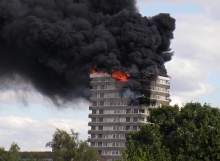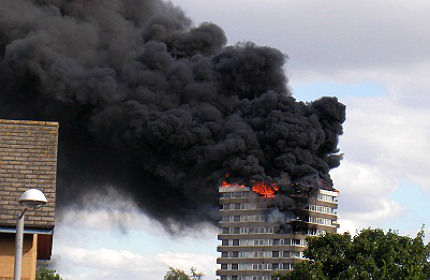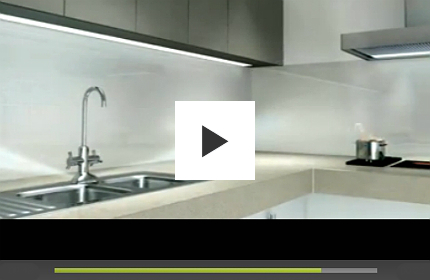

London suffered its worst tower block fire on 3 July 2009 when a blaze took hold of Lakanal House, Camberwell, killing six people. The fire, caused by an electrical fault in a television on the ninth floor, spread quickly despite the building being designed to contain fires in an afflicted block for up to an hour. Failed by botched renovation work, Southwark council’s failure to inspect the building and a confused firefighting operation, a recent inquest concluded that the six victims, aged between 20 days and 34 years old, needn’t have died.
Tower block fires have, disturbingly, become increasingly common in the United Arab Emirates. During the much-publicised property boom, cheap materials with a gloss finish were sought to facilitate demand. After a string of fires, the materials used in exterior cladding were found to be highly combustible, allowing fires to spread rapidly once alight.
With safety a paramount issue of any construction project, thought has quickly turned towards ensuring the safety of residents through any means necessary. Tighter regulations, new materials and emerging technologies have now come to the fore, backed by an overwhelming desire to ensure that catastrophes like that at Lakanal House are averted.
Compartmentation
One such means of protecting residents during a fire is considered during the design process. Compartmentation is a method of ‘built-in’ passive fire protection, wherein should a fire start in one particular block or room, it can be contained for up to one hour, allowing residents time to escape and emergency services to attend the scene.
The process involves subdividing buildings into manageable areas of risk through the use of fire walls and floors, with particular materials used to quell the spread of the fire. Due to high-rise blocks being more reliant on compartmentation than smaller buildings, it’s usually the case that each individual flat is deemed to be an individual block or cell, with walls containing fire-resistant materials to not only keep the fire within that particular block, but to prevent escape routes from becoming impeded.
This should have been the case with Lakanal House, with the building supposed to have been sufficiently compartmentalised during previous renovation. Emergency services continually advised some residents to stay inside their flats, believing the building to have been properly compartmentalised.
Evidence given at the inquest was, however, damning. Asbestos window panels had been replaced with composite equivalents during a refurbishment, and these panels burned out within five minutes – causing the fire to spread more quickly than predicted. Fire safety checks were supposed to have been conducted by a change in the law occurring in 2006, but by July 2009 Southwark council had still not checked Lakanal House. A comprehensive fire safety examination would have uncovered the flaw, potentially saving lives. Passive fire protection, it would seem, can only be deemed a reliable precaution when strictly enforced.
The curse of combustible cladding
Another case of chosen construction materials potentially endangering lives has occurred in Dubai, with cheap cladding being blamed for an increasing number of tower block infernos.
High-rise towers in the oil-rich city have been pieced together to look as aesthetically pleasing as possible, with a particular type of façade appearing across Dubai. Recent estimates suggest that up to 70% of high-rise buildings in Gulf States use them, despite them having been banned for use in the UK since 1980.
The cladding comprises a thermoplastic core which, while difficult to set alight, remains highly combustible. Should an individual panel catch fire, it would not be long before it exploded, spreading the fire across a large area of the building. "The facades are good-looking, long-lasting and easy to maintain, but they have one big problem – they burn rapidly," said Middle East Centre for Sustainable Development chief technical officer Thom Bolen during an interview with the BBC.
New legislation prohibits the use of such panels, noting a mineral-rich alternative that has been proven to be considerably less combustible, but only in new builds. Tower-blocks constructed prior to the legislative change are not enforced to change cladding panels, meaning that the threat of a spontaneous fire is still very much present.
Retrofitted sprinklers the key to safety
With fires occurring at heights often requiring specialist equipment to reach and combat them, the emergency services often lose any advantage gained by a speedy arrival. Retrofitted sprinkler systems could, in theory, hold the key to combating fires as and when they occur.
"What the Lakanal House inquest has highlighted are major failings in the way high-rise fire safety is being addressed in the UK today," says Safety Management managing director Brian Gregory, highlighting the installation of sprinkler systems into individual flats to tackle fires as soon as they’re detected.
"They can be retro-fitted at a reasonable cost, they should be installed in every new high-rise building constructed in the UK and it should be a matter of law," affirms Gregory, citing the fact that there has yet to be a single fatality in any high-rise block across the world fitted with a sprinkler system.
One particular company has gone as far as to produce a sprinkler system which blends seamlessly with regular kitchen fittings. The Automist system, developed by Plumis, comprises of a pump fitted beneath the kitchen sink that is activated through a wireless heat detection system in the event of a fire, forcing water through a nozzle attached to the tap at high pressure.
The resulting mist douses the blaze within seconds of its detection, providing an instantaneous advantage to first responders. The mist is doubly effective as it turns into steam upon contact with the fire, stealing heat from the source. The expansion of the water also deprives the flame of oxygen, reducing the fire’s source of fuel.
Although it would be foolhardy to suggest that such a system could be the sole solution needed to combat such devastating events as the Lakanal House fire in the future, the need for comprehensive fire safety strategies simply cannot be dismissed.
Although flame retardant materials can certainly contribute, it has become clear that without stricter and tighter controls, any effort to improve fire safety lacks the framework to succeed.
Related content
Timber in the city: the new cosmopolitan construction material of choice
Thanks to its glowing green credentials, the use of timber for urban housing is experiencing a new renaissance, especially in the UK.
The world’s most sustainable buildings
Green buildings are shooting up from the ground as countries race to meet environmental and sustainability targets.




